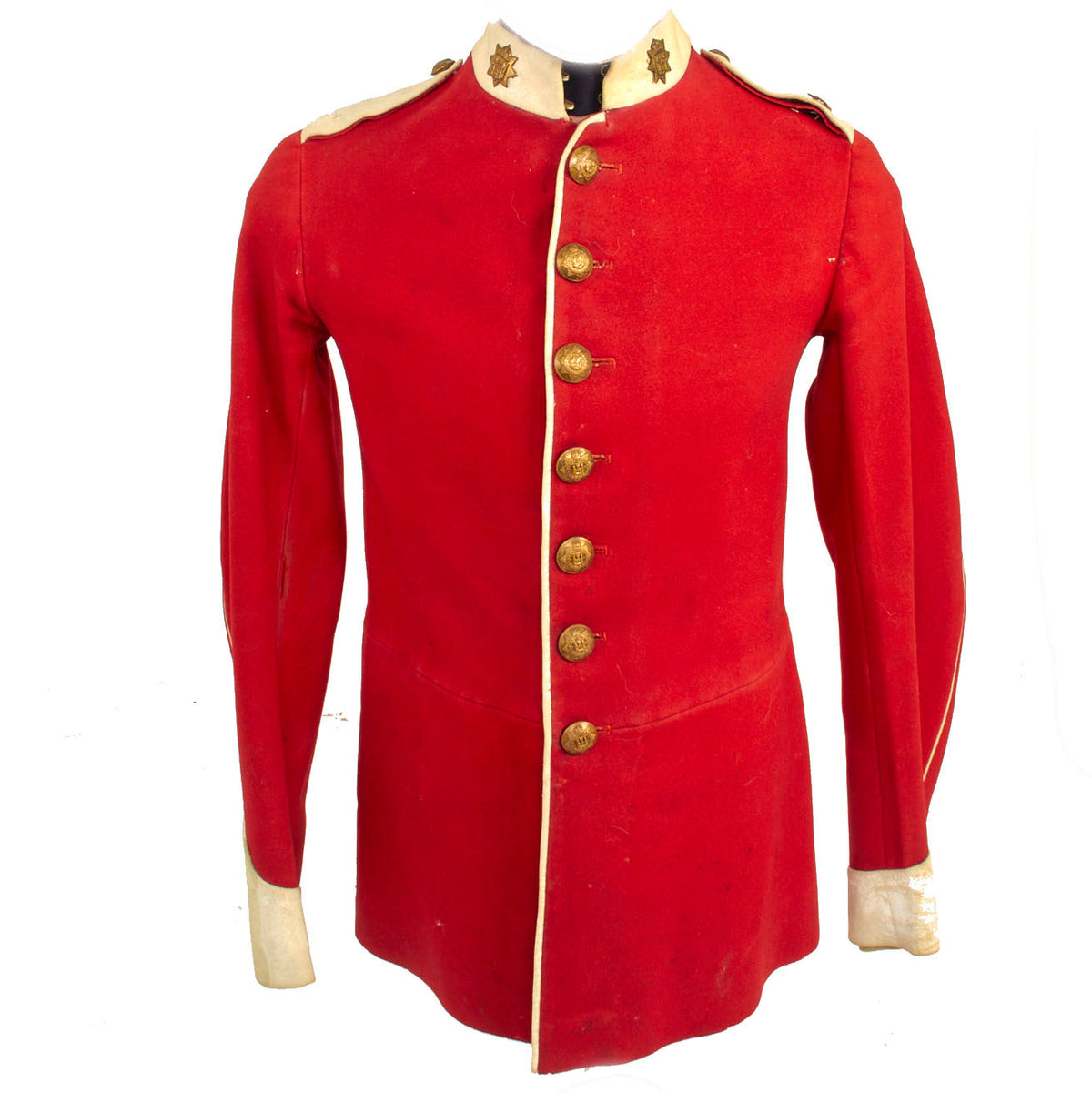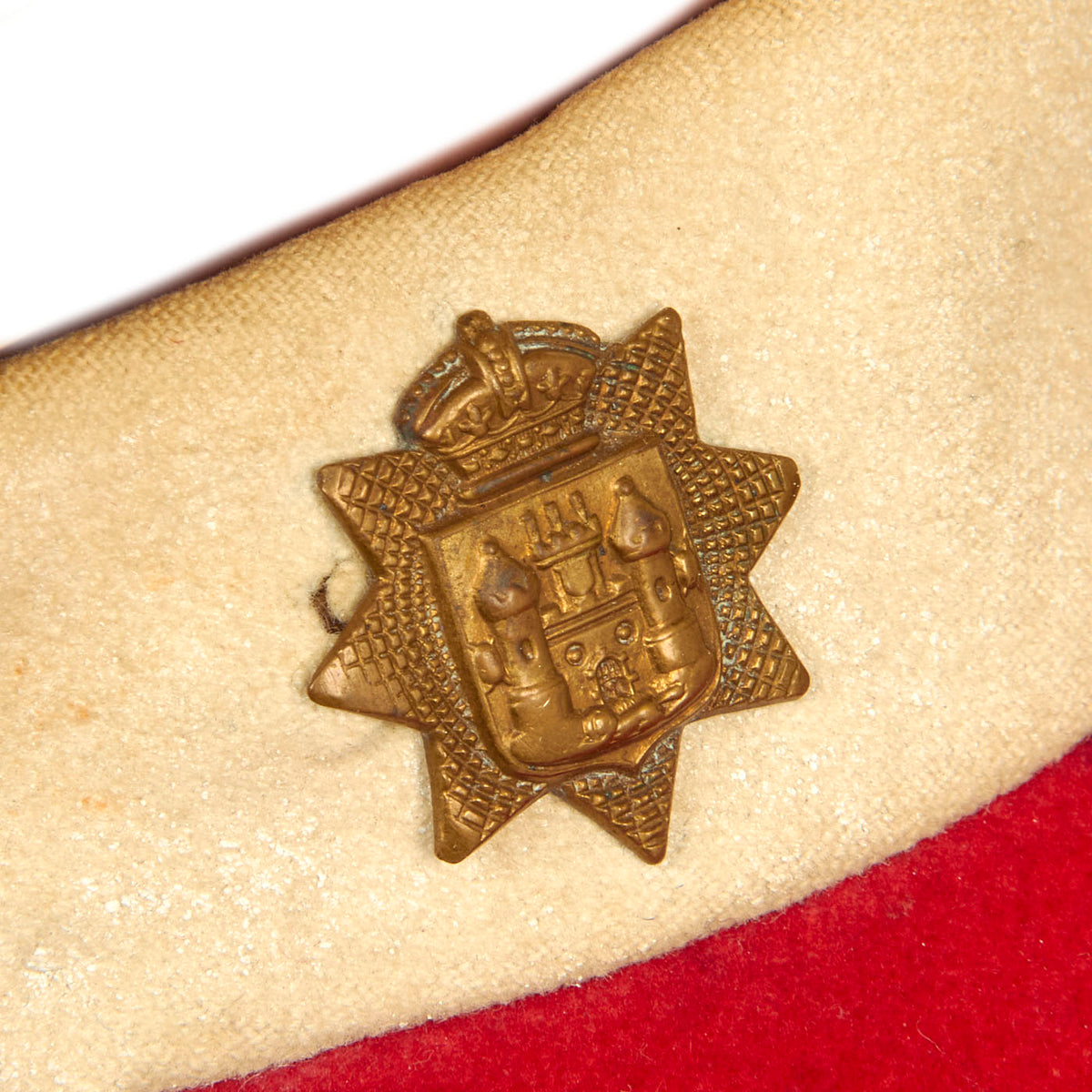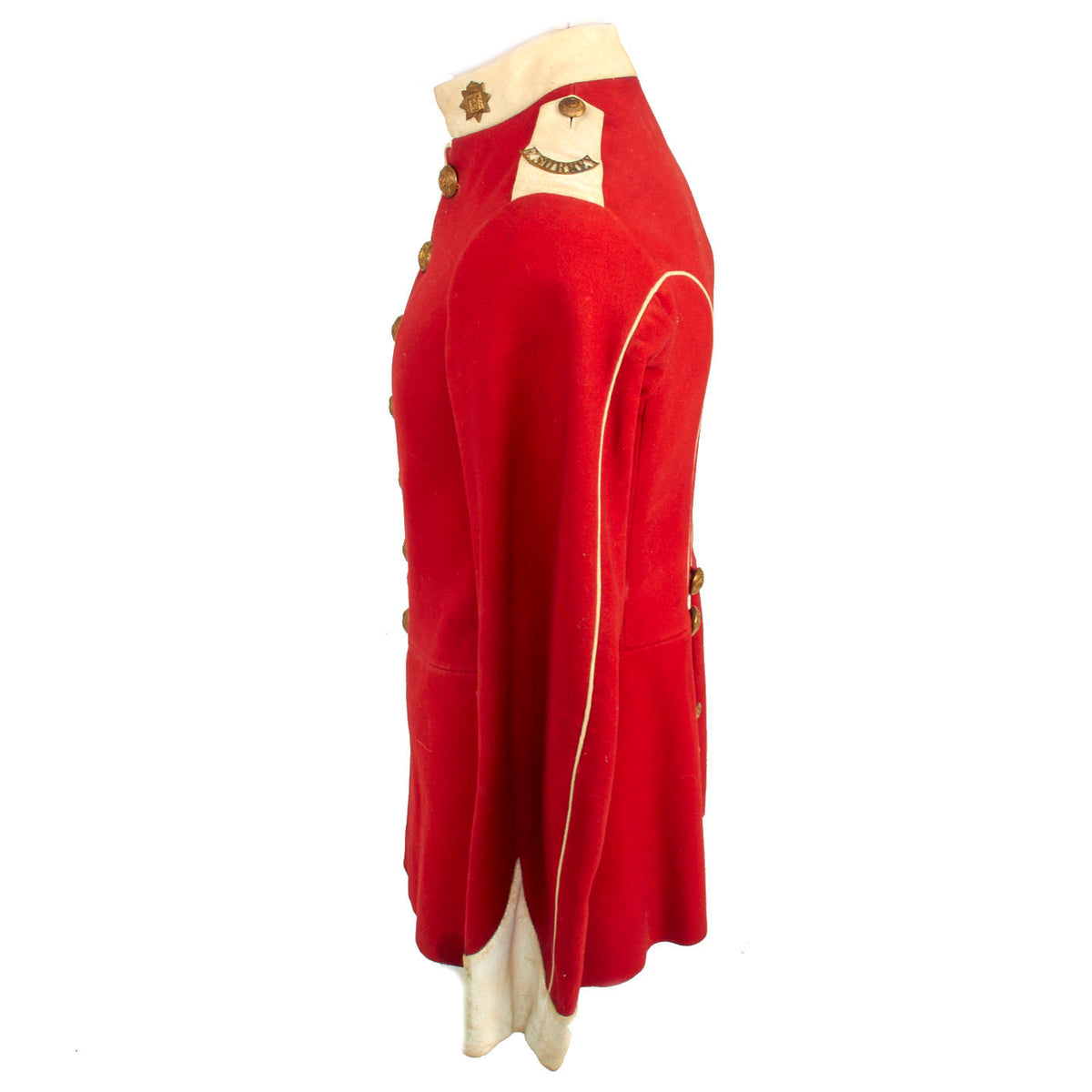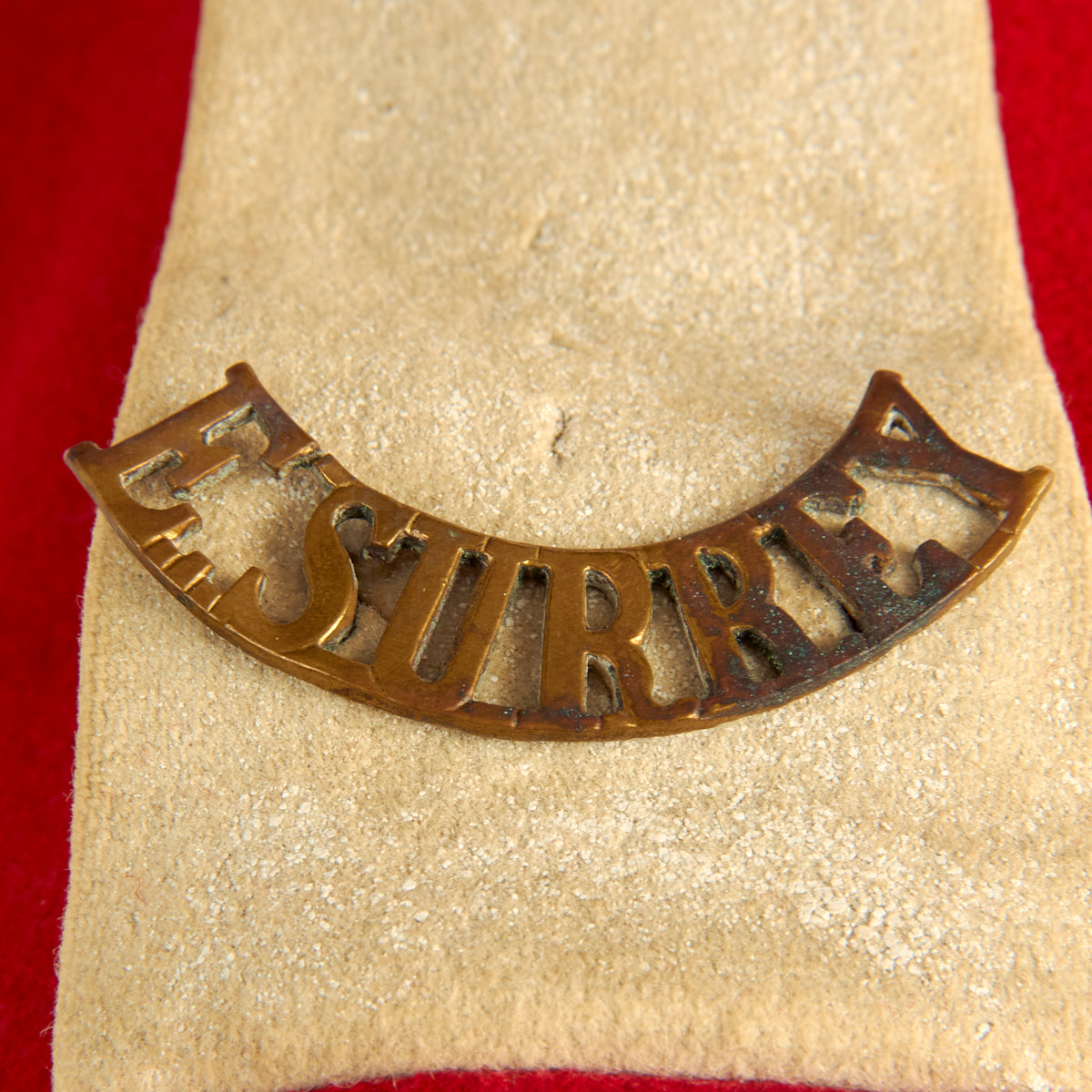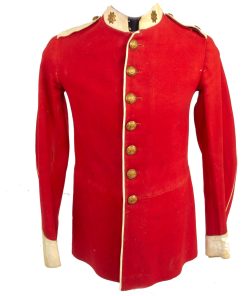Original British Victorian Named 1881 Pattern East Surrey Regiment Scarlet Tunic – Johnnie Wade Original Items
$ 295,00 $ 118,00
Original Item: Only One Available. Red coat or scarlet tunic was a military garment used widely, though not exclusively worn, by most regiments of the British Army, Royal Marines, and some colonial units within the British Empire, from the 17th to the 20th centuries. The scarlet tunic continues to be used into the 21st century, with several armed forces of the Commonwealth of Nations adopting them as their full dress and mess dress uniforms. The uniform and term “redcoat” may have originated in 16th century Tudor Ireland as a derogatory term for the British, as British soldiers in Lord Lieutenant of Ireland’s army wore red coats, the first time English and Scottish soldiers under English command and later British collectively had a red uniform. The term reportedly was then brought to America and Europe by Irish emigrants.
From the mid-17th century to the 19th century, the uniform of most British soldiers (apart from artillery, rifles and light cavalry) included a madder red coat or coatee. From 1873 onwards, the more vivid shade of scarlet was adopted for all ranks, having previously been worn only by officers, sergeants and all ranks of some cavalry regiments.
Following the discomfort experienced by troops in the Crimean War, a more practical tunic was introduced in 1855, initially in the French double-breasted style, but replaced by a single-breasted version in the following year. An attempt at standardization was made following the Childers Reforms of 1881, with English and Welsh regiments having white facings (collar and cuffs), Scottish yellow, Irish green and Royal regiments dark blue. However some regiments were subsequently able to obtain the reintroduction of historic facing colors that had been uniquely theirs.
British soldiers fought in scarlet and blue uniforms for the last time at the Battle of Gennis in Sudan on 30 December 1885. They formed part of an expeditionary force sent from Britain to participate in the Nile Campaign of 1884–85, wearing the “home service uniform” of the period. This included scarlet “frocks” (plain jackets in harder-wearing material designed for informal wear), although some regiments sent from India were in khaki drill. A small detachment of infantry which reached Khartoum by steamer on 28 January 1885 were ordered to fight in their red coats in order to let the Mahdist rebels know that the real British forces had arrived.
Even after the adoption of khaki Service Dress in 1902, most British infantry regiments (81 out of 85) and some cavalry regiments (12 out of 31) continued to wear scarlet tunics on parade and for off-duty “walking out dress”, until the outbreak of the First World War in 1914. While nearly all technical and support branches of the army wore dark blue, the Royal Engineers had worn red since the Peninsular War in order to draw less fire when serving amongst red-coated infantry.
Scarlet tunics ceased to be a general issue upon British mobilization in August 1914. The Brigade of Guards resumed wearing their scarlet full dress in 1920, but for the remainder of the army redcoats were only authorized for wear by regimental bands and officers in mess dress or on certain limited social or ceremonial occasions (notably attendance at court functions or weddings). The reason for not generally reintroducing the distinctive full dress was primarily financial, as the scarlet cloth requires expensive cochineal dye dyed in the grain of the cloth by old-fashioned methods.
As late as 1980, consideration was given to the reintroduction of scarlet as a replacement for the dark blue “No. 1 dress” and khaki “No. 2 dress” of the modern British Army, using cheaper and fadeless chemical dyes instead of cochineal. Surveys of serving soldiers’ opinions showed little support for the idea and it was shelved.
This tunic was seen being worn from around 1882 to the early 1900s and we believe this one to be early 1890s. The tunic was worn by a Johnnie Wade and we attempted to find service information but came up empty, making for a wonderful research opportunity. The tunic is complete with all buttons but is missing a shoulder designation for E. SURREY. The overall condition is very good considering the age. There is moth nips scattered throughout but nothing too damaging and does not subtract from the beauty.
A wonderful example ready for further research and display.
Approximate Dimensions:
Collar to shoulder: 9”
Shoulder to sleeve: 26”
Shoulder to shoulder: 15”
Chest width: 16.5”
Waist width: 16.5”
Hip width: 20”
Front length: 30″
The East Surrey Regiment was a line infantry regiment of the British Army in existence from 1881 until 1959. The regiment was formed in 1881 under the Childers Reforms by the amalgamation of the 31st (Huntingdonshire) Regiment of Foot, the 70th (Surrey) Regiment of Foot, the 1st Royal Surrey Militia and the 3rd Royal Surrey Militia.
In 1959, after service in the Second Boer War and both World War I and World War II, the East Surrey Regiment was amalgamated with the Queen’s Royal Regiment (West Surrey) to form the Queen’s Royal Surrey Regiment, which was, in 1966, merged with the Queen’s Own Buffs, The Royal Kent Regiment, the Royal Sussex Regiment and the Middlesex Regiment (Duke of Cambridge’s Own) to form the Queen’s Regiment. The Queen’s Regiment was subsequently amalgamated with the Royal Hampshire Regiment to form the present Princess of Wales’s Royal Regiment (Queen’s and Royal Hampshires).
Fast Shipping with Professional Packaging
Thanks to our longstanding association with UPS FedEx DHL, and other major international carriers, we are able to provide a range of shipping options. Our warehouse staff is expertly trained and will wrap your products according to our exact and precise specifications. Prior to shipping, your goods will be thoroughly examined and securely secured. We ship to thousands clients each day across multiple countries. This shows how we're dedicated to be the largest retailer on the internet. Warehouses and distribution centres can be located throughout Europe as well as the USA.
Note: Orders with more than one item will be assigned a processing date depending on the item.
Before shipping before shipping, we'll conduct a thorough inspection of the items you have ordered. Today, the majority of orders will be delivered within 48 hours. The delivery time will be between 3-7 days.
Returns
The stock is dynamic and we cannot completely manage it because multiple stakeholders are involved, including our factory and warehouse. So the actual stock may alter at any time. It's possible that you may not receive your order once the order has been made.
Our policy is valid for a period of 30 days. If you don't receive the product within 30 days, we are not able to issue a refund or an exchange.
You can only return an item if it is unused and in the same state as the day you received it. You must have the item in its original packaging.
Related products
Uncategorized
Uncategorized
Uncategorized
Armoured Fighting Vehicles of the World: AFVs of World War One (Hardcover Book) New Made Items
Uncategorized
Uncategorized
Uncategorized
Uncategorized
Uncategorized
Uncategorized
Uncategorized
Uncategorized
Armored Burgonet Helmet & Polearm from Scottish Castle Leith Hall Circa 1700 Original Items
Uncategorized
Uncategorized
Uncategorized
Australian WWII Owen MK1 Machine Carbine SMG Custom Fabricated Replica with Sling Original Items
Uncategorized
Uncategorized
Uncategorized
Uncategorized
